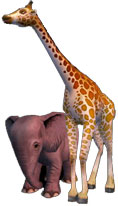Building a World
All objects in a 3D environment are constructed from simple flat triangles known as polygons. These polygons are connected together at various angles to form three-dimensional shapes. A flat square, for example, consists of two polygons, whereas a cube contains twelve polygons. (Since it resembles a sculpture molded from a wire mesh, a polygonal object is sometimes called a wireframe model.)
A graphic texture is applied to the surface of an object to give it detail. Let’s say a game designer wanted to create a virtual cereal box. He’d begin with a simple box shape and then apply images to each of its flat surfaces. This same process is used to apply faces, clothing, and other important textures to three-dimensional objects.
The final step is to apply lighting to the environment. In order to convey realism, all objects must reflect and refract light in a consistent fashion. In an environment where the sun is low in the west, the western side of all object must be illuminated. The opposite side of the object should be darkened, and the object would cast a shadow to the east. Reflection and transparency must also be calculated for water, glass, and other elements.

